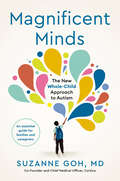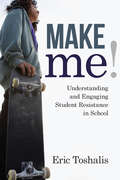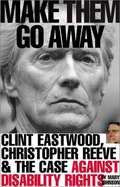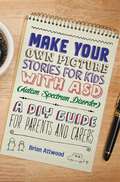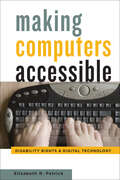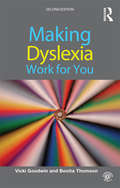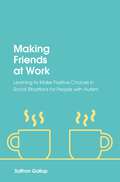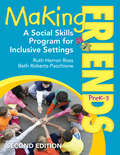- Table View
- List View
Maggie By My Side
by Beverly ButlerWhen cancer unexpectedly struck down Beverly Butler's guide dog, Una, it hurt to imagine another dog taking her place. Yet it was because of what Una and three other dedicated dogs before her had given her in terms of independence and dignity that made getting a new dog as certain as sunrise. In Maggie By My Side, she tells of the challenges, hazards, and joys of training with Maggie, her fifth guide dog since losing her sight at fourteen. It is also an account of the foibles, quirks, and devotion of the guide dogs who preceded Maggie. Part of the story is poignant--the anguish of Una's death--and part is hilarious--Maggie's introduction to the family cats. In this lively narrative we learn the history of guide dogs, what it takes to become a trainer, how new guide dogs come to be, and share in the vivid firsthand experiences that bring it all to life. This is a Junior Literary Guild selection, chosen as an outstanding book for boys and girls (A Group). Pictures are described.
Magic Licking Lollipops: Targeting the l Sound (Speech Bubbles 2)
by Melissa PalmerLynn and Lily love licking lollipops, and lollies of all colours, shapes and sizes. But this time, have they bitten off more than they can chew? This picture book targets the /l/ sound and is part of Speech Bubbles 2, a series of picture books that target specific speech sounds within the story. The series can be used for children receiving speech therapy, for children who have a speech sound delay/disorder, or simply as an activity for children’s speech sound development and/or phonological awareness. They are ideal for use by parents, teachers or caregivers. Bright pictures and a fun story create an engaging activity perfect for sound awareness. Picture books are sold individually, or in a pack. There are currently two packs available – Speech Bubbles 1 and Speech Bubbles 2. Please see further titles in the series for stories targeting other speech sounds.
Magnets and Ladders: Fall/Winter 2011-2012
by Active Voices of Writers with DisabilitiesMagnets and Ladders is an online literary magazine that features poems, short stories, memoirs, and personal essays by writers with disabilities. The magazine is divided into sections that reflect the content of selections and voice of the authors. Topics include: life events, memoir, science fiction, nature, current issues, music, art, travel, and the craft of writing. Stories and poems about holidays and the season are also featured. Although the authors published in Magnets and Ladders have disabilities, most of their writing is not about disability. These authors have had a multitude of enriching experiences and they are proud to share them with you. www.behindoureyes.org
Magnets and Ladders: Fall/Winter 2012-2013
by Active Voices of Writers with DisabilitiesMagnets and Ladders is an online literary magazine that features poems, short stories, memoirs, and personal essays by writers with disabilities. The magazine is divided into sections that reflect the content of selections and voice of the authors. Topics include: life events, memoir, science fiction, nature, current issues, music, art, travel, and the craft of writing. Stories and poems about holidays and the season are also featured. Although the authors published in Magnets and Ladders have disabilities, most of their writing is not about disability. These authors have had a multitude of enriching experiences and they are proud to share them with you.
Magnets and Ladders: Fall/Winter 2013-2014
by Active Voices of Writers with DisabilitiesMagnets and Ladders is an online literary magazine that features poems, short stories, memoirs, and personal essays by writers with disabilities. The magazine is divided into sections that reflect the content of selections and voice of the authors. Topics include: life events, memoir, science fiction, nature, current issues, music, art, travel, and the craft of writing. Stories and poems about holidays and the season are also featured. Although the authors published in Magnets and Ladders have disabilities, most of their writing is not about disability. These authors have had a multitude of enriching experiences and they are proud to share them with you.
Magnets and Ladders: Fall/Winter 2014-2015
by Active Voices of Writers with DisabilitiesMagnets and Ladders is an online literary magazine that features poems, short stories, memoirs, and personal essays by writers with disabilities. The magazine is divided into sections that reflect the content of selections and voice of the authors. Topics include: life events, memoir, science fiction, nature, current issues, music, art, travel, and the craft of writing. Stories and poems about holidays and the season are also featured. Although the authors published in Magnets and Ladders have disabilities, most of their writing is not about disability. These authors have had a multitude of enriching experiences and they are proud to share them with you.
Magnets and Ladders: Fall/Winter 2015-2016
by Active Voices of Writers with DisabilitiesMagnets and Ladders is an online literary magazine that features poems, short stories, memoirs, and personal essays by writers with disabilities. The magazine is divided into sections that reflect the content of selections and voice of the authors. Topics include: life events, memoir, science fiction, nature, current issues, music, art, travel, and the craft of writing. Stories and poems about holidays and the season are also featured. Although the authors published in Magnets and Ladders have disabilities, most of their writing is not about disability. These authors have had a multitude of enriching experiences and they are proud to share them with you.
Magnets and Ladders: Fall/Winter 2016-2017
by Active Voices of Writers with DisabilitiesMagnets and Ladders is an online literary magazine that features poems, short stories, memoirs, and personal essays by writers with disabilities. The magazine is divided into sections that reflect the content of selections and voice of the authors. Topics include: life events, memoir, science fiction, nature, current issues, music, art, travel, and the craft of writing. Stories and poems about holidays and the season are also featured. Although the authors published in Magnets and Ladders have disabilities, most of their writing is not about disability. These authors have had a multitude of enriching experiences and they are proud to share them with you.
Magnets and Ladders: Spring/Summer 2012
by Active Voices of Writers with DisabilitiesMagnets and Ladders is an online literary magazine that features poems, short stories, memoirs, and personal essays by writers with disabilities. The magazine is divided into sections that reflect the content of selections and voice of the authors. Topics include: life events, memoir, science fiction, nature, current issues, music, art, travel, and the craft of writing. Stories and poems about holidays and the season are also featured. Although the authors published in Magnets and Ladders have disabilities, most of their writing is not about disability. These authors have had a multitude of enriching experiences and they are proud to share them with you.
Magnets and Ladders: Spring/Summer 2013
by Active Voices of Writers with DisabilitiesMagnets and Ladders is an online literary magazine that features poems, short stories, memoirs, and personal essays by writers with disabilities. The magazine is divided into sections that reflect the content of selections and voice of the authors. Topics include: life events, memoir, science fiction, nature, current issues, music, art, travel, and the craft of writing. Stories and poems about holidays and the season are also featured. Although the authors published in Magnets and Ladders have disabilities, most of their writing is not about disability. These authors have had a multitude of enriching experiences and they are proud to share them with you.
Magnets and Ladders: Spring/Summer 2014
by Active Voices of Writers with DisabilitiesMagnets and Ladders is an online literary magazine that features poems, short stories, memoirs, and personal essays by writers with disabilities. The magazine is divided into sections that reflect the content of selections and voice of the authors. Topics include: life events, memoir, science fiction, nature, current issues, music, art, travel, and the craft of writing. Stories and poems about holidays and the season are also featured. Although the authors published in Magnets and Ladders have disabilities, most of their writing is not about disability. These authors have had a multitude of enriching experiences and they are proud to share them with you.
Magnets and Ladders: Spring/Summer 2015
by Active Voices of Writers with DisabilitiesMagnets and Ladders is an online literary magazine that features poems, short stories, memoirs, and personal essays by writers with disabilities. The magazine is divided into sections that reflect the content of selections and voice of the authors. Topics include: life events, memoir, science fiction, nature, current issues, music, art, travel, and the craft of writing. Stories and poems about holidays and the season are also featured. Although the authors published in Magnets and Ladders have disabilities, most of their writing is not about disability. These authors have had a multitude of enriching experiences and they are proud to share them with you.
Magnets and Ladders: Spring/Summer 2016
by Active Voices of Writers with DisabilitiesMagnets and Ladders is an online literary magazine that features poems, short stories, memoirs, and personal essays by writers with disabilities. The magazine is divided into sections that reflect the content of selections and voice of the authors. Topics include: life events, memoir, science fiction, nature, current issues, music, art, travel, and the craft of writing. Stories and poems about holidays and the season are also featured. Although the authors published in Magnets and Ladders have disabilities, most of their writing is not about disability. These authors have had a multitude of enriching experiences and they are proud to share them with you.
Magnets and Ladders: Spring/Summer 2017
by Active Voices of Writers with DisabilitiesMagnets and Ladders is an online literary magazine that features poems, short stories, memoirs, and personal essays by writers with disabilities. The magazine is divided into sections that reflect the content of selections and voice of the authors. Topics include: life events, memoir, science fiction, nature, current issues, music, art, travel, and the craft of writing. Stories and poems about holidays and the season are also featured. Although the authors published in Magnets and Ladders have disabilities, most of their writing is not about disability. These authors have had a multitude of enriching experiences and they are proud to share them with you.
Magnificent Minds: The New Whole-Child Approach to Autism
by Suzanne GohAn essential primer based on a renowned new model of care that is comprehensive and research based, while honoring the uniqueness of every childAn estimated one in thirty-six children in the United States is diagnosed with autism. New research has shed light on the many factors that determine a child&’s trajectory—but many parents are still navigating this complex terrain without a road map. Pediatric neurologist Dr. Suzanne Goh has spent decades working with autistic children, and in this practical and research-based guide she shares her renowned and revolutionary model of care: an innovative, whole-child approach that combines optimal medical treatment with the most effective strategies for advancing cognition, communication, and behavior. Demystifying a wide range of diagnostics and therapies and offering new insights into the neurological, biochemical, behavioral, and social factors that play a role in successful outcomes, the book is an essential resource for understanding all of autism—a strengths-based approach that helps parents design a comprehensive treatment plan. It is also a celebration of what each autistic person brings to the world—and how parents can best nurture the remarkable uniqueness of their child while setting them up for the future they envision.
Mainstreaming and the American Dream: Sociological Perspectives on Parental Coping with Blind and Visually Impaired Children
by Howard Nixon IIBased on in-depth interviews with parents and professionals, this research monograph presents a sociological framework for looking at the needs and aspirations of parents of blind and visually impaired children.
Major League Dad
by Gregg Lewis Christine Burke Tim BurkeTestimony of former Major League pitcher whose family adopted four special-needs children.
Make Me!: Understanding and Engaging Student Resistance in School (Youth Development and Education Series)
by Eric ToshalisIn this groundbreaking book, Eric Toshalis explores student resistance through a variety of perspectives, arguing that oppositional behaviors can be not only instructive but productive. All too often treated as a matter of compliance, student resistance can also be understood as a form of engagement, as young people confront and negotiate new identities in the classroom environment. The focus of teachers&’ efforts, Toshalis says, should not be about &“managing&” adolescents but about learning how to read their behavior and respond to it in developmentally productive, culturally responsive, and democratically enriching ways. Noting that the research literature is scattered across fields, Toshalis draws on four domains of inquiry: theoretical, psychological, political, and pedagogical. The result is a resource that can help teachers address this pervasive classroom challenge in ways that enhance student agency, motivation, engagement, and academic achievement. The coauthor ofUnderstanding Youth: Adolescent Development for Educators (Harvard Education Press, 2006), Toshalis blends accessible explanations of theory and research with vignettes of interactions among educators and students. In Make Me!, Toshalis helps teachers perceive possibility, rather than pathology, in student resistance.
Make Them Go Away: Clint Eastwood, Christopher Reeve and the Case Against Disability Rights
by Mary JohnsonHow the anti-ADA forces prevailed
Make Your Own Picture Stories for Kids with ASD (Autism Spectrum Disorder): A DIY Guide for Parents and Carers
by Brian AttwoodPicture stories can play a vital role in helping parents negotiate challenging scenarios with kids with ASD. Yet no matter how many books and flashcards you have, they can't cover every eventuality. So, suppose you could draw the stories yourself... Brian Attwood took up pen and paper when his son John's meltdowns became harder to deal with. The effect was immediate and time and time again picture stories have bailed the family out of trouble and saved John from unhappiness and confusion. In this book, Brian describes step-by-step how to create simple yet effective picture stories using basic drawings and short lines of text, and provides examples based on real-life situations for you to adapt for your child. This book will give parents and carers the tools and confidence they need to create individualised picture stories to help their child with ASD cope with social situations, difficult emotions, transitions and other challenging situations.
Making Computers Accessible: Disability Rights and Digital Technology
by Elizabeth R. PetrickThe revolution in accessible computer technology was fueled by disability activism, the interactive nature of personal computers, and changing public policy.In 1974, not long after developing the first universal optical character recognition technology, Raymond Kurzweil struck up a conversation with a blind man on a flight. Kurzweil explained that he was searching for a use for his new software. The blind man expressed interest: One of the frustrating obstacles that blind people grappled with, he said, was that no computer program could translate text into speech. Inspired by this chance meeting, Kurzweil decided that he must put his new innovation to work to "overcome this principal handicap of blindness." By 1976, he had built a working prototype, which he dubbed the Kurzweil Reading Machine.This type of innovation demonstrated the possibilities of computers to dramatically improve the lives of people living with disabilities. In Making Computers Accessible, Elizabeth R. Petrick tells the compelling story of how computer engineers and corporations gradually became aware of the need to make computers accessible for all people. Motivated by user feedback and prompted by legislation such as the Americans with Disabilities Act, which offered the promise of equal rights via technological accommodation, companies developed sophisticated computerized devices and software to bridge the accessibility gap. People with disabilities, Petrick argues, are paradigmatic computer users, demonstrating the personal computer’s potential to augment human abilities and provide for new forms of social, professional, and political participation. Bridging the history of technology, science and technology studies, and disability studies, this book traces the psychological, cultural, and economic evolution of a consumer culture aimed at individuals with disabilities, who increasingly rely on personal computers to make their lives richer and more interconnected.
Making Dyslexia Work for You
by Vicki Goodwin Bonita ThomsonWritten for dyslexic adults or anyone who thinks they might be dyslexic, this bold and imaginative book is deliberately concise and easy to dip into. User-friendly, essential guide to the world of study and work for anyone with dyslexia; Identifies the key needs of adults and young people who are dyslexic; Encourages them to put together their own package of ideas and strategies for success; Offers practical activities, examples and support covering reading, memory, organization, self-esteem, IT and dyslexia in the workplace; Over 100 topics from this book are expanded on our online resource. This unique guide to overcoming the day-to-day difficulties associated with dyslexia will also be of great interest to employers, colleagues, teachers, friends and family of those with dyslexia.
Making Friends at Work: Learning to Make Positive Choices in Social Situations for People with Autism
by Saffron GallupMaking new friends at work can be tricky - it's tough to predict how people will react to certain situations. This 'choose your own response' book can show you how these situations could potentially play out. Some endings are positive and some less so, and the book includes explanations about why particular outcomes may have occurred, so you can learn to avoid those situations. The best part is you can go back and see how a different choice can change the outcome of the story!
Making Friends, PreK–3: A Social Skills Program for Inclusive Settings (Second Edition)
by Ruth Herron Ross Elizabeth L. Roberts-PacchioneHelping students develop healthy social skills is child’s play <p><p> This newly retitled edition of the popular Wanna Play provides hundreds of fun and updated activities that help children learn how to behave appropriately and make friends. Ideal for teachers, counselors, and behavior therapists, included are tools for teaching emotion regulation, team-playing, and body safety to all children, making this resource an excellent fit for inclusive settings. New features include: <p> A social interaction checklist for identifying learners’ strengths and weaknesses <p> Teacher-friendly activities that can be used in small groups or with the whole class <p> A chapter on emotions
Making Impressions: A Handbook for the Prospective Guide Dog Handler 3rd Edition
by Jenine Mckeown StanleyThis little handbook created by Guide Dog Users Inc. offers information, considerations and suggestions on what you should do when considering partnering with a guide dog. This book gives advice on what considerations you should take into account when choosing a guide dog school, questions and considerations you should ask yourself while in training. The book also gives an outline of what training is like, and things you should bring, as well, as things to help you as a new team after graduation. Advocacy is discussed as well as due process for those situations that can not be resolved. Excellent resource for anyone who is considering taking the plunge and working with a guide dog. And it is also good for those who arleady have a guide dog.


